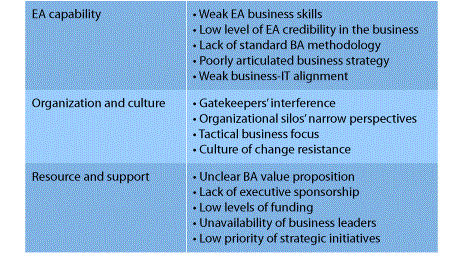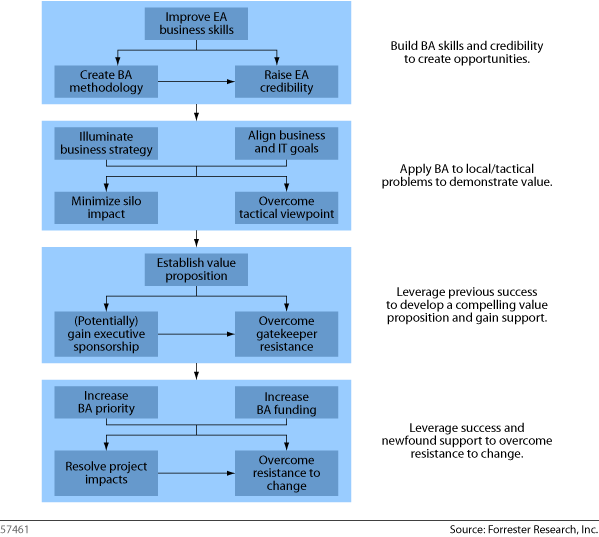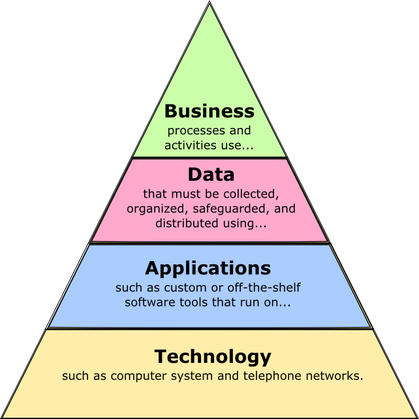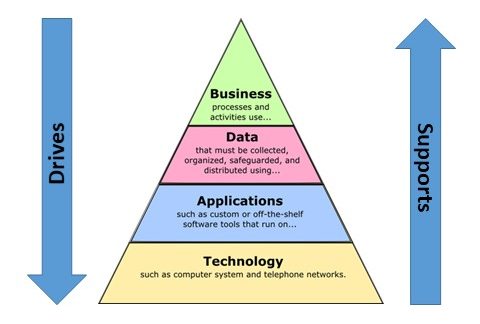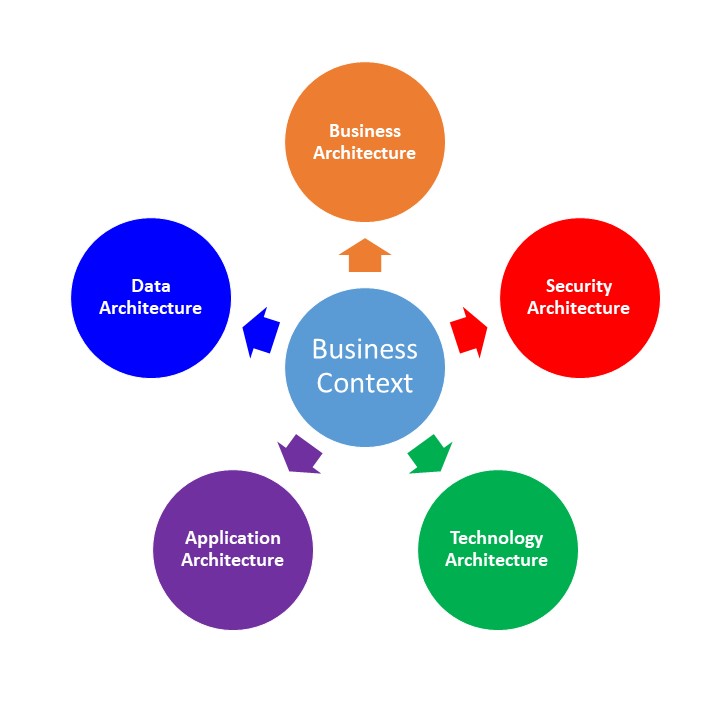Posts Tagged EA874 Topic 6
Architecture of the Future
The Enterprise Business Architecture, Part 3
So what will the Architecture of the Future look like? As much as it would be fun to explore futuristic architectural designs of buildings, that’s not what we are talking about. We know that over the last 10 years, the make-up of Enterprise Architecture has changed from process-oriented to business-outcome driven. This week’s topic has been specifically about the Enterprise Business Architecture, so what is the anticipation of change coming to this specific view of EA?
Gordon Barnett of Forrester wrote an article entitled “Business Architecture 2020 – Extending Beyond Organizational Boundaries” back in 2013. In 2016, he updated this article and it was renamed “Business Architecture 2020 – Evolving to Influence Business Strategy”. In this updated report, Barnett briefly summarizes a perspective of the future of Business Architecture, based on current trends in business and EA. The report includes 2 main takeaways (Barnett, 2016):
- Business Architecture will expand beyond Organizational Boundaries
- By 2020, Organizations will need different types of Business Architects
Let’s dig a little deeper into each of those topics.
Business Architecture will expand beyond Organizational Boundaries
As organizations have changed to be more global in nature, Business Architecture will need to reflect this shift as well. It is more common for organizations to have more dealings with external contractors, third-party vendors, partners, etc. Today’s Business Architect is focused on the internal organizational environment. However, tomorrows Business Architect will need need to shift their focus to the external environment which incorporates a much larger business ecosystem (Barnett, 2016). Barnett points out 2 key changes in this shift of focus:
External influence on strategic decisions will increase.
“Today, business strategy determines the market in which to compete and how the organization will win. External influence on business strategy is very limited. By 2020, as consumer and partner behaviors shift, organizations will need to extend their focus to the complete value-creation networks. External influence, particularly from customers, employees, and partners, will increase, and executive committees will need to react accordingly. BA focus will extend beyond the existing organization boundaries to include collaborating third parties, i.e., partners and customers. Organizations and BA leaders must understand the impact of these third parties on the agility of an organization’s strategy and on the delivery of value and experience to customers.”Partner influence on the strength of an organizations capabilities will grow.
For an organization to realize its mission requires a set of business capabilities: what an organization needs to satisfy its mission. Unless the organization undertakes a diversification strategy, the organization’s business capability needs will remain static. However, over time, the how, where, and who (the processes, information, technology, and people) will change to reflect the economic requirements and strategy of the organization.
In the future, the advancement of technology and innovation in business practices will broaden the ways in which partners influence the structure of an organization. Many organizations will focus only on their core business capabilities, with the noncore business capabilities provided by third parties; for example, an entity like ADP may provide payroll. This restructuring of the operating model will force BA to understand the maturity of these externally provided business capabilities and how they hinder or support the organization’s strategic intent.
Organizations will need Different Types of Business Architects
As the scope of Business Architecture widens, the individual skills of business architects will also need to grow. As more and more business architects become part of the normal business environment, there will be a need for business architects with varying skills, including many specializations. This may include focuses in specific business domains, corporate strategy or even analysis of industry trends. According to Barnett, this new breed of business analyst will have skills focused on (Barnett, 2016):
Strategic management. Many BA leaders state that their primary focus is strategic alignment or strategic direction/choice. However, very few BA leaders are actually at the table when firms are making strategic decisions. As 2020 approaches, the need for a deep understanding of an organization’s industry or market ecosystem will grow. Firms will need to answer a variety of questions, including determining the types of strategic relations needed to support business objectives. Ecosystem business architects will have opportunities to move into this space and join the strategic management group reporting directly to the CEO.
Analysis techniques and methods. Today, business architects have developed a core set of competencies to build internal blueprints of the organization. By 2020, as the scope of business architecture extends from a purely internal view of the organization to one that includes the organization’s operating environment, BA leaders will need to develop additional strategic and ecosystem analysis skills. This will involve mastering techniques such as political, economic, social, and technological (PEST) and customer-centric PEST (cPEST) analysis; Porter’s five forces; scenario analysis; persona analysis; journey maps; and other ecosystem analysis techniques.
Also, because the performance of an organization’s partners will help determine its performance, BA leaders will need to acquire skills to assess performance and dependency analysis, a form of systems thinking. In particular, business architects will need to answer questions such as these: What areas of the business performed outside of expectations? Why did this happen? Was this a one-off, or is it a trend?External relationship management. Today’s BA practices are recruiting business architects that have demonstrated mastery in soft skills, including communication, negotiation, facilitation, and diplomacy skills. In a world where business architecture extends beyond the boundaries of the organization, some stakeholders of business architecture will be external to the organization. Thus, business architects will need not only these soft skills but also external relationship management skills to address the different motivations and cultures of the external stakeholders.
Business model transformation and innovation. In the age of the customer and the world of digital business, executives will need the assistance of subject matter experts (SMEs) in the fields of customer life cycles and digital businesses. In particular, SME business architects will guide and influence strategy decisions that focus on delivering digitally enhanced experiences that add value in the context of their customers’ needs rather than purely on channel strategies. Firms will then be in a better position to combine digitally connected products and services to meet customer needs and deliver more value than the sum of their parts.
Barnett concludes his article with a few recommendations, of which they all primarily can be summarized as “start preparing your business architects now for the future.” If his predictions are accurate, then the investment now of additional training, organizational change, and the general extending of the business architecture practice will clearly pay off down the road.
References:
Barnett, Gordon. (2016). Business Architecture 2020 – Evolving to Influence Business Strategy. Forrester. Retrieved November 5, 2017 from https://www.forrester.com/report/Business+Architecture+2020+Evolving+To+Influence+Business+Strategy/-/E-RES95381
Architectural Challenges
The Enterprise Business Architecture, Part 2
Image Source: DesignBoom
Architectural Photographer and Artist, Filip Dujardin, has a special talent. He can create images such as the photo above, which, at first glance, appear unusual yet somewhat plausible. Upon careful inspection, though, these buildings are actually impossible. He is able to take multiple digital elements and create these surreal buildings. According to Dujardin, “the building becomes real if the shadows are well done.”
So what does that have to do with Business Architecture?
The fact is that many organizations claim to have setup an Enterprise Architecture including the Business Architecture viewpoint, but in reality it’s just on paper. It’s not real..!!! Even if the organization claims to have been successful, there is no tangible benefit that is being realized. In fact, roughly 2/3 of all EA initiatives are considered to have failed.
Specifically in the Business Architecture arena, only a small percentage of programs are actually delivering value back to the organization. Forrester published a report in 2010 listing the top 14 Business Architecture Challenges and some recommendations on how to overcome those challenges. Instead of regurgitating what author Jeff Scott wrote, I think his article stands on it’s own (Scott, 2010):
Fourteen Business Architecture Challenges And How To Overcome Them
EAs Are Challenged By Their Own Business Architecture Capabilities
Though business architecture has been part of the basic EA model from its inception, only in recent years have EAs focused there. Business architecture knowledge, skills, and methodology are all lagging general EA by a decade or more, and because business architecture is fundamentally different from technology architecture, the learning curve is very steep. The good news is that EA teams can overcome these challenges without much help or support from the rest of the organization. The following challenges are within EA’s scope to resolve:
- Weak EA business skills. Most EA teams are composed of some of the organization’s strongest technologists. Their past experience, interest, and current EA roles keep them overly focused on technology topics with little time — and often little inclination — to improve their business and business architecture knowledge. Successful business architects are allocating time to read business books, interact with business mentors, and learn about the fundamentals of their company’s business model. Non-IT-based business architects come to the table with M.B.A.s and business-specific experience.
- A low level of EA credibility in the business. Fifty-four percent of EA teams report to a senior-level executive such as a CIO or CTO, while the rest report lower in the IT organization. With little business visibility, many aspiring business architects are virtually unknown to business leaders. In addition, many EA teams have unintentionally created a negative impression through their efforts to hold project teams to architectural standards. Successful EA teams position the EA practice as a project resource as opposed to a controlling function, thereby turning their IT peers into business architecture (BA) advocates who promote them to the business.
- A lack of industry-standard business architecture methodology. Business architecture is still in its infancy. While there are a number of “meta methodologies” in the public domain, they are neither comprehensive nor robust. Business architects are still experimenting with which approaches work best. For the foreseeable future, business architects will have to craft their methodology from what is available and continue to evolve it over time.
- Poorly articulated business strategy. Many architects might disagree that this is an EA team issue, but Forrester believes it is a core responsibility of the business architect to identify, clarify, and document business intent. Business leaders are skeptical of the value of a documented business strategy because they have rarely seen a good one. Often architects address this challenge informally, gaining small wins with the business before tackling an enterprise view. Architects that create a well-articulated view of business strategy report an “aha” reaction from their business executives.
- Weak business-IT alignment. Contributing to many EA teams’ lack of business credibility is the fact that they reside in an IT organization that is poorly aligned with business goals. Architects take one of two opposing strategies to overcome this challenge. One is to meet it head-on and apply EA and business architecture specifically to helping improve alignment. The other is to distance EA from the IT culture to present a different viewpoint to the business.
EAs Are Challenged By The Business Culture That Surrounds Them
While BAs are still trying to figure out what a really great business architecture looks like, they are facing an even bigger challenge in connecting with organizations that are not designed or predisposed to work in a coordinated, strategic fashion. The organization and cultural challenges BAs face are:
- IT gatekeepers who prevent EA’s interaction with the business. Most IT organizations have established business relationship managers as a formal or informal role. Whether they are project managers or senior IT executives, they play an important role in managing the business relationship by providing a single point of contact and by isolating the business from many of the day-to-day nuances of managing IT. Strong gatekeepers create a formidable challenge to EA, and successful architects most often partner with them as opposed to try to circumvent them.
- Organizational silos that make it difficult to get the big picture. Business unit independence is the norm and is a natural occurrence spawned by dealing with span of control challenges. Successful business architects use this to their advantage by cultivating a relationship with one business unit and leveraging success there to gain access to others.
- A tactical business focus. Quarterly financial reporting, a lack of corporate strategic thinking, and the fast pace of business environment change drive short-term business thinking. Convincing business leaders to explore a strategic viewpoint is challenging. Successful approaches to this challenge usually begin with finding a specific problem business architecture can solve as opposed to trying to sell the larger concept.
- A culture of change resistance. Almost all organizations resist change unless their business model is based on product innovation. Resistance to change is a very powerful force, as it is usually rooted within each individual’s perspective of what he or she has to do to be successful. Resistance to change can rarely be “solved” but instead must be managed. Architects who manage change well first develop a plan to understand the factors that are creating resistance and then attack those issues by lowering the perceived risk of doing something different.
EAs Are Challenged By Lack Of Support And Resources
Architects can’t build business architecture in a vacuum. They need the support, or at least the attention, of a number of businesspeople at various levels of the organization. Most business architecture efforts are small and only require minimal funding; however, like any other initiative, they do need money — and the more they have, the faster they can proceed. Developing a clear value proposition can be the most challenging aspect of building business architecture. The resource and support challenges BAs face are:
- Business architecture has yet to establish a compelling value proposition. Business architecture is still relatively new; few companies are far enough along the path to report the value they are receiving. As with other EA domains, BA value is hard to specify until architects do enough work to show results. Current BA approaches that are showing results typically focus on specific problems or a single business unit.
- Business architecture rarely has executive sponsorship. Though many architects list executive sponsorship as a critical success factor (CSF), few are reporting that they have it. Securing sponsorship is somewhat of a “chicken and the egg” problem. Architects want sponsorship to drive support for BA but generally have to make enough progress to demonstrate value to gain sponsorship. Architects that do gain executive sponsorship typically first show results at a project or departmental level.
- EA teams rarely have specific business architecture funding. Without a clear and compelling value proposition, most EA teams find that BA funding is limited. Many have made the case to hire a single business architect to round out the EA team, but few have established funding for specific BA initiatives. Successful BA startup efforts leverage a small number of resources to manage a larger number of non-EA participants.
- Availability of business resources is low. Business executive and senior management time is a scarce commodity. Most business managers are overworked, often finding themselves with a full calendar of meetings most days. Consequently, they are very careful about committing the little free time they have. Executive sponsorship can overcome this challenge, but most BAs are forced to work at a lower level with the intent to move up in the organization as they produce results.
- Strategic activities have low priority. Most organizations are tactically focused with little appreciation of the strategic value of architecture and strategy. Most business managers are accustomed to seeing strategy efforts as a waste-of-time planning exercise. BAs report making headway when they judiciously apply strategic tools to help solve current problems.
The Solution is in the Connection of the Challenges
Taken individually, these challenges can seem overwhelming, but this is a problem of not seeing the forest for the trees. Putting the challenges in context creates a clear picture of how to proceed (see figure below). To tame these BA challenges:
- Assess the challenges you face. Not all business architects will face all 14 challenges, nor will each challenge present the same level of difficulty. Lay out the challenges in road map form that clarifies your business architecture effort’s current position and indicates future steps. Focus your attention and energy on the next challenge you need to address.
- Build foundational success first. Though the solutions are not completely as sequential as Figure 3 indicates, building a strong foundation is crucial to achieving long-term success. In general, executive sponsorship and funding can only be solved when you have a compelling value proposition, which you can only create once you have demonstrated value in some way, which you can only do when you have the right skills and capabilities. Attempting to skip steps will only lead to frustration and additional work to recover lost ground.
- Demonstrate value to overcome organizational challenges. Organizations will rarely get behind a BA initiative because it is the right thing to do. Everyone wants to know “what’s in it for me?” Find opportunities to add value to build up credibility. Typical places business architects are getting early traction are in business transformation projects, business-IT alignment initiatives, annual IT and business planning exercises, merger and acquisition activities, and large process improvement initiatives.
References:
Scott, Jeff. (2010). Fourteen Business Architecture Challenges And How To Overcome Them. Forrester. Retrieved October 30, 2017 from https://www.forrester.com/report/Fourteen+Business+Architecture+Challenges+And+How+To+Overcome+Them/-/E-RES57461
Fat Bottomed Strategies make the Enterprise Go Round
The Enterprise Business Architecture, Part 1
Image Source: Aviana Technologies
In previous classes as well as the beginning of this class, we discussed how Enterprise Architecture (EA) is traditionally thought of as having 4 distinct viewpoints:
- Business Architecture Layer
- Data Architecture Layer
- Application Architecture Layer
- Technology Architecture Layer.
In recent years, the importance of security has become a much higher priority and many organizations now treat the Security Architecture as a fifth distinct viewpoint within the EA. However it is important to note that there is a distinct flow to the parts, as noted by the wording in the above graphic. From the top down, the layers define the scope and boundaries of the layer below them. From the bottom up, each layer supports the architecture of the layer above it.
This week, we are talking about the Enterprise Business Architecture (EBA), the keystone of our EA “pyramid” diagram. And as the diagram suggests, the business layer drives all the rest of the viewpoints of the Enterprise Architecture while those other viewpoints are ultimately supporting the business architecture.
Gartner defines the EBA as:
That part of the enterprise architecture process that describes — through a set of requirements, principles and models — the future state, current state and guidance necessary to flexibly evolve and optimize business dimensions (people, process, financial resources and organization) to achieve effective enterprise change.
As with information, technology and solution architectures, the EBA process translates the strategy, requirements and vision as defined in the business context into contextual-, conceptual-, logical- and implementation-level requirements. Using this process, EBA, as well as all the EA viewpoints, should demonstrate clear traceability of architectural decisions to the elements of the business strategy.
Gartner continues in the article, discussing one of the main issues regarding this concept of Business Architect, in that it is often confused with Business Context. Business Context is defined in the article as the “process of articulating the business strategy and requirements and ensuring that the enterprise architecture effort is business-driven.” In other words, the business context defines directly how the EA is related to the business strategy and how they interact with each other. It gives us a perspective on how the business operates. Back in EA872, I wrote about how the “context provides the enterprise architects with the proper frame of reference in which to link together the EA Principles, Business Strategies and Business Initiatives.” The Business Context provides us with that frame of reference for all aspects of EA, including the Business Architecture.
So the Business Context provides the frame of reference, while the Business Architecture is the organization and structure of the business processes, organizational elements, business strategy and requirements, and business rules. Simply put, the Business Context defines the “Why” while the Business Architecture defines the “What” and “How”. This is true of each of the 4 other EA layers we have been reviewing in the past weeks. Each of those layers gives us a snapshot view into the “What” and “How” of their respective fields within the business. The Business Context not only provides the “Why” for each of the EA layers, but more importantly, it provides a method to understand how the 5 layers work together to fulfill the overall business strategy.


